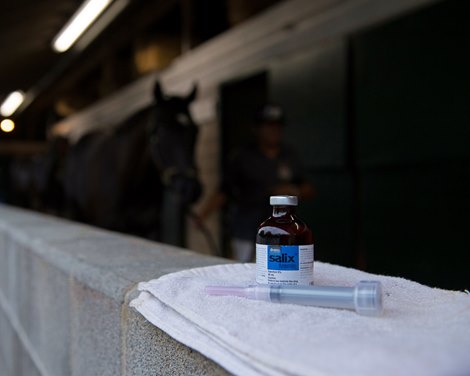An article published in the current issue of the Journal of the American Veterinary Medical Association calls for further investigation into a link between Lasix operate in racehorses and sudden death.
The article “Fifteen Risk Factors Associated with Sudden Death in Thoroughbred Racehorses in North America (2009-2021)” was written by Euan D. Bennet and Tim Parkin. The The paper is included in the October 20 issue of JAVMA.
Lasix (the diuretic furosemide), approved on race day in North America to prevent or reduce the severity of exercise-induced pulmonary hemorrhage, was among 15 risk factors significantly associated with sudden death. It found that “horse racers taking furosemide medication had a 62% increased risk of sudden death.”
Given these numbers in the study, the paper calls for further investigation.
“The association between furosemide and sudden death requires further investigation to understand what biological processes might contribute to this outcome,” the paper says.
Sign in Blood horse Daily
Under current medication regulations, most horses in the United States are allowed to race with Lasix, and most trainers choose to treat their horses with it. The most common exceptions to horses racing without it are 2-year-olds and stake competitors. Many racing jurisdictions prohibit the operate of Lasix on race day for these types of horses.
The study concludes that other factors associated with sudden death include the horse's age and gender, the price of the race, the race distance and the horse's recent injury or stalling history.
“Associations between previous injuries and sudden death suggest that, in some cases, pre-existing pathologies may contribute,” the paper says.
Salix, better known as Lasix
The study relied on the Jockey Club's Equine Injury Database, and Parkin is an England-based veterinary epidemiologist who has advised the EID since its launch. Through a study by EID, the industry has made a number of changes in various areas to support reduce catastrophic musculoskeletal injuries, which have accounted for the expansive majority of horse racing deaths since 2009.
While sudden deaths not related to musculoskeletal injuries account for only 7.4% of all fatal incidents, the industry has improved safety through a gradual process rather than a silver bullet. On the musculoskeletal side, this included, among other things, changes to medication regulations, eligibility rules, purse strings, and increased efforts to improve surface safety. Many of these changes were introduced to address risk factors identified in the EID.
This gradual approach has helped racing reduce horse fatalities by 30.5% since 2009. The rate of 1.39 per 1,000 starts in 2021 is a record low for the industry since 2009, when it began tracking rates. One way to put this number is that there were no horse deaths in 99.86% of starts in 2021.
As these gradual changes have led to a reduction in musculoskeletal injuries, Parkin, who heads the University of Bristol's veterinary faculty, sees potential for further advances in horse safety by addressing the smaller subset of sudden deaths musculoskeletal injuries. Since 2009, these sudden deaths have occurred at a rate of 0.13 per 1,000 launches. In June at the Welfare and Safety of the Racehorse Summit at Keeneland | BloodHorse.com route profile”.KeenelandParkin outlined some of the findings on sudden death contained in the paper.
He noted that the problem had come into greater public focus because some high-profile horses had suffered sudden deaths in recent years. In December, disqualified Kentucky Derby Presented by Woodford Reserve (G1) winner Medina Spirit died after a workout Santa Anita Park. The California Horse Racing Board later announced that an autopsy could not determine exactly why the Grade 1-winning colt collapsed and died after a workout on Dec. 6, but said the results suggested acute heart failure without it gave a confirmation.
Although neither the CHRB nor Parkin addressed a connection between taking Lasix and Medina Spirit's sudden death, it was one of two medications in his body at the time of his death. The CHRB reported that omeprazole, an anti-ulcer drug, and Lasix were detected in blood and urine samples. These results were consistent with the medication report submitted to the CHRB by the colt's treating veterinarian.


